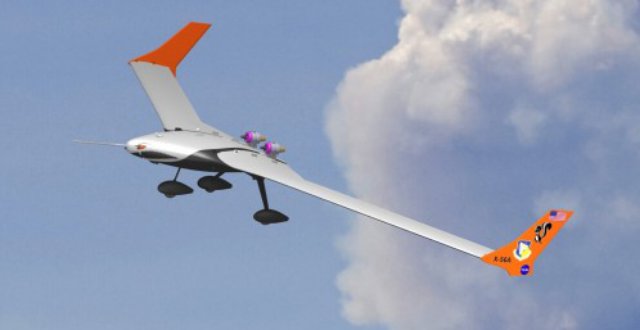This is a more recent picture of the X-56A – the latest ‘X’ plane unveiled by the United States Air Force and NASA. Developed with Lockheed Martin’s famed Skunk Works, it is a modular aircraft designed to test an unusual method of alleviating flutter in lightweight aircraft. Rather than relying upon structural strength to keep the wing in one piece, it uses computing power.
The potential for flutter problems gets worse as engineers try to design planes to fly higher and longer with even more slender wings than are seen on some of the latest unmanned aircraft.
While any kind of aircraft can be affected (or even bridges), the long and slender, high aspect ratio wings on airplanes such as the Predator and Global Hawk are particularly susceptible to flutter. The efficient wing design allows the airplanes to fly for long periods of time at high altitude, but engineers are limited by the fine balance between weight and strength. An even more slender wing might be better, and could potentially allow longer and higher flights. But as of now such wings aren’t possible because more strength (and weight) is usually what is used to combat the potential for flutter.
NASA and the Air Force hope to develop designs for future high-altitude aircraft that minimize the risk of flutter while maintaining the absolutely minimal weight of the slender, efficient wings needed to stay aloft for hours or even days at a time. And they want to do this by relying on a computer to control the flutter by moving the control surfaces to counter the vibrations before they increase to a destructive amplitude.
With a wingspan of just 28 feet, the X-56A is a small-scale version of current high altitude unmanned aircraft. Engineers operating the flying test bed will attempt to intentionally induce flutter in the wings and to see if the fly-by-wire flight control computer can eliminate any problems that arise. The ability of a flight computer to control small changes as an airplane flies through turbulent skies is not new — but the Air Force and NASA want to take the test to the “edge of the envelope” and perhaps beyond.
The X-56A research project includes four separate sets of wings. One is relatively stiff to create a baseline for the tests. The remaining three sets are flexible wings that make it easier to induce flutter and test the fly-by-wire computer’s ability to reduce or eliminate the potentially destructive phenomenon. The airplane is equipped with a parachute in case the wing is destroyed in flight.
When flutter does occur in the X-56A’s slender wings, the on-board flight computer will manipulate the flight control surfaces on the wings in an attempt to reduce it. Although some fly-by-wire aircraft have been able to reduce the oscillations, the typical solution is to simply increase the strength (and weight) of the structure.
Source: Wired Danger Room

